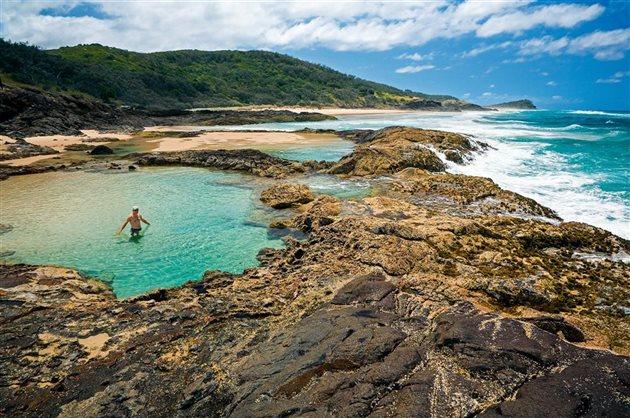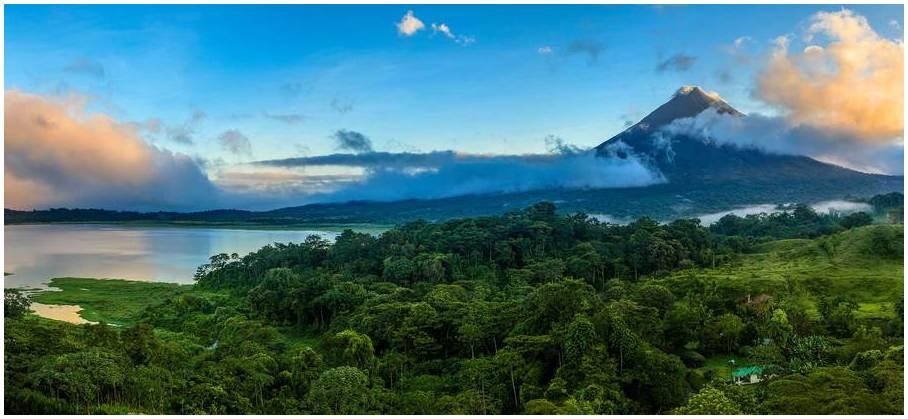Australia' s Great Barrier Reef is said to be the oceanic equivalent of the Amazon rainforest. The largest living thing on Earth, the only one visible from the moon. The territory from Brisbane to Cairns is conditioned by this magnificent reef, despite being several kilometres away from the coast. The journey north is thus punctuated by a string of cities and islands that act as stepping stones to the coral paradise.
Always attentive to the fashions of London and New York. This is Brisbane, the capital of the state of Queensland and one of Australia's five major cities. However, Queenslanders are becoming increasingly mindful of their own land, largely because of the threat to their most precious treasure, the Great Barrier Reef, which is in danger of disappearing if global temperatures rise by two degrees. So Australians are changing their habits, and in Brisbane, the southern gateway to the Great Barrier Reef, there is a fever for healthy living that transcends food labelling and creeps into newscasts, newspapers and talk shows. Almost any street corner in the city centre offers a freshly squeezed orange or mango juice, cyclists and joggers abound, canoeists paddle the Brisbane River and children climb walls along Kangaroo Point.
The Great Barrier Reef, which is in danger of disappearing if global temperatures rise by two degrees Celsius.
All this without sacrificing glamour, because Brisbane has a waterfront saturated with business centres, cafés and restaurants with diaphanous windows. It's South Bank Parkland, a bustling entertainment area on the south bank of the Brisbane River that even has a man-made beach and a park with koalas, crocodiles and platypuses. This is a city of parks and bridges - seven of them - equipped with jogging lanes and enlivened by flower stalls and buskers. The oldest part of the city occupies a pointed peninsula that is skirted by tour boats as they travel along the river. Here you'll find the Botanic Gardens and the Italianate-looking City Hall, whose 91-metre-high tower offers stunning views of the city.
Queensland's coastline
After savouring Brisbane's cosmopolitanism, it's time to head for the coral along the Bruce Highway, the road that runs parallel to the Queensland coast. Open spaces are the order of the day in this pastoral landscape, interrupted by the occasional house or petrol station. The town of Hervey Bay stretches for several kilometres along the waterfront, with houses spaced far apart along a narrow road known as the Esplanade. Visitors arriving along this road are the only attraction that breaks up the monotony of Hervey Bay.
The town's main attraction is the 40-minute boat ride to Fraser Island, a World Heritage Site and an unmissable part of the trip. This elongated strip of land is flanked by underwater grasslands that are frequented by whales, turtles and dugongs, a small, cetacean-like, snub-nosed mammal. Among the island's many oddities is a forest on sand with tall trees such as redwoods and prehistoric ferns; Fraser is home to many warnings about dingoes (wild dogs) and tides. The north belongs to Great Sandy National Park, an area of rock formations and dunes that reserves one of the few safe swimming areas, the Champagne Pools.
Back on the mainland, 126 kilometres north, you'll reach Bundaberg, the main wharf for ferries approaching the Great Barrier Reef. Bundaberg has a country feel of tangerine and courgette pickers, dusty vans and pubs where you sing along to Kurt Cobain hits while watching rugby on TV and playing pool. Just outside, in the direction of the Mon Repos tortoise reserve, the air smells of sugar from the distillery where Bundaberg's famous rum is produced.
Where to stay
If you're planning a trip to Queensland and want to be close to the action, staying Hotels in Queensland near Suncorp Stadium on www.queenslandhotelmotel.com is an excellent choice. This iconic stadium hosts various sporting events, concerts, and entertainment shows, making it a vibrant and exciting area to stay in. Luckily, there are plenty of accommodation options to suit every traveler's preferences.
Experience the convenience of being just steps away from Suncorp Stadium by staying in hotels located in the nearby precinct. Enjoy the bustling atmosphere and easy access to events and attractions. Find the best hotels here.
Pet-Friendly Aparthotels in Brisbane:
Traveling with your furry friend? Brisbane offers several Brisbane Pet friendly Aparthotels, combining the comfort of a home with the amenities of a hotel. Enjoy a delightful stay with your beloved pet by your side.
The first coral islands
From the Bruce Highway itself you can see the silhouette of Lady Elliot and Lady Musgrave, the islands that open the reef and attract the most visitors. Of the two, Lady Musgrave is less exploited and offers a purer contact with Australia's underwater treasure: there's crescent algae, razor corals and polyps among which tropical species such as budions, labros, clownfish and butterflyfish scurry. Every day flights and boats arrive from Bundaberg and Hervey Bay, carrying diving enthusiasts from all over the world.
Back on the mainland, thousands, millions of sugar canes grow along the road, and long, long trains with wagons full of cane lie like worms across the plains. The sugar reaches as far as Rockhampton, though this town is more of a cattle town, as evidenced by the steaks its inhabitants devour even at breakfast. Rockhampton has the feel of an enlarged Bundaberg, but much further from the coast. To catch up with the coral line, you return north on the Bruce Highway and continue to take in this vast, unpopulated area where thousands of cows and zebu graze.
After driving 300 kilometres alongside bales of hay, Mackay comes into view. It is one of the world's great sugar-loading centres, an activity that attracted thousands of workers from southern Europe in the 1950s. Mackay is a quiet, prosperous town, with wide streets and numerous art deco buildings with signs that evidence its trade links with Hong Kong. The sea is about five kilometres away and is honoured with sculptures of animals, such as turtles and dolphins, as well as poems extolling the neighbouring Eungella mountain range, the waving platypus and the strength of the oak tree. Around five in the afternoon, flocks of parrots take over the coconut trees at the junction of Victoria and Wood Street.
Mackay is the port that links to the Whitsundays, an archipelago of about a hundred rugged islands surrounded by underwater corals despite their distance from the reef. Because of their continental origin - they were formed by rising seas after the last ice age - they have lush vegetation on their peaks and beaches where dwarf palms and spiky fossils grow.
Townsville and Magnetic Island
The line of islands that emerges off the coast stretches for almost four hours from Mackay to Townsville, the largest of the Great Barrier Reef towns. The administrative and commercial capital of North Queensland, Townsville grew up on the back of gold deposits found in 1867. The scorching sun and high humidity are as intense as they were back then, but today the town also boasts a mix of avant-garde and Victorian architecture, an aquarium dedicated to the Great Barrier Reef and proximity to Magnetic Island. A twenty-minute drive takes you to the island that drove Captain Cook's compass crazy in 1770 and where you can now take comfortable strolls along paths flanked by eucalyptus trees hugged by koalas.
Of all the islands in this area, Hinchinbrook is the largest of the world's listed national park islands and also the largest of the 600 mainland islands that make up the reef. The ancient land of the Bandjin and Giramay, so fierce that they managed to avoid settlers, remains virtually untouched. Separated from the mainland town of Cardwell by a narrow channel, Hinchinbrook invites you to explore mangrove mazes and white sandy beaches, as well as to wander into the forest and climb to the top of panoramic peaks via the 32-kilometre Thosborne Track.
Cairns grew overnight thanks to the discovery of tin and gold deposits and sugar cane.
Hinchinbrook is a scene at the antipodes of Cairns, north Queensland's tourist base. Since the 1960s, Cairns has provided an ideal base from which to catapult into the natural spectacles of this region: the rainforest of the Atherton Tablelands, a volcanic plateau which is climbed by an 1891 locomotive; the Cape York Peninsula, Australia's far north; and, of course, the Great Barrier Reef, to which day trips are scheduled.
Founded in 1876 by settlers from the south, Cairns grew overnight thanks to the discovery of tin and gold deposits and sugar cane. Today, travellers from all over the world have found Cairns' slogan "a world of coral" a compelling argument for all kinds of environmental advocacy. Many non-conformists and metropolis-weary travellers have discovered a sophisticated Ithaca in Cairns. Who knew that, two centuries ago, this was a sea slug camp until gold forced the Aboriginal yirriganydjs to bid farewell to their way of life.
North of Cairns
For a glimpse of what Cairns was once like, head north along the Captain Cook Highway. The sugar town of Mossman, 78 kilometres away, hides a gorge studded with waterfalls and, a short distance away, the Daintree National Park is home to a rainforest like the one that covered Australia a hundred million years ago, where river cruises allow you to spot freshwater crocodiles. And for all its beauty, the Great Barrier Reef is still crying out for attention. At the end of the trip, what could be more appetising than a dive among the corals of Lizard Island, where Captain Cook made landfall to locate a passage through the most beautiful reef on the planet.
FIND OUT MORE
Documents: Passport and e-visa available from the Australian Embassy.
Language: English
Currency: Australian dollar
Time difference: 9 hours.
Precautions: Take heed of the signs warning about sea conditions and animals. Drink plenty of water and use sunscreen.
How to get there: Several airlines fly from Spain to Brisbane, usually with a stopover in a European city and another in an Asian city. The flight takes about 25 hours including stopovers. The airport is served by bus and train services to the city centre.
Getting around: Domestic flights, trains and coaches help bridge long distances. A rental car is recommended for driving along stretches of the coast and for sightseeing near cities. Driving is on the left. Ferries to the islands are very frequent.


